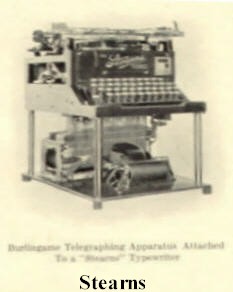The Burlingame Telegraphing Typewriter
The booklet What Burlingame Did provides some vague descriptions of the actual instrument. Photographs are provided of the "Burlingame Telegraphing Apparatus" attached to a Stearns Typewriter and to a L.C. Smith Typewriter.


The machine sits under the typewriter like a deck, and obviously the keys are somehow connected to it. The photos are reasonably good, but it is impossible to figure much out.
The following is the description of the operation of the equipment:
"He takes two ordinary typewriters of standard make, such as the Stearns, L.C. Smith, Underwood or Monarch. The two that the writer observed were the "Stearns," and they were the same machines that one would buy in the market for office use. Each was equipped with the electrical apparatus to set the electrical waves n motion and record them at the other end.
The operator sits at the sending typewriter and operates the machine just as the ordinary stenographer types letters. The message is recorded on the receiving instrument as perfectly as though it were a carbon copy of the original. Likewise the sending machine makes a copy of the message just as it is sent. The system is a sending, receiving and recording operation, all in one.
Each letter on the keyboard, as well as the characters, numerals and punctuation marks has its own individual combination of electrical impulses. By magnetic attraction the types bars on the receiving machine are attracted toward the roller where the paper rests.
When the letter "A", for example, is struck on the key of the sending machine, a set of electrical impulses is set in motion over the wire which releases the letter "A" on the receiving machine and the type prints the letter on the paper roll. So on through the whole keyboard the operation is the same. In like manner, the shift key, the device for changing from capitals to small letters and vice versa, the spacing between words, the return of the carriage and the spacing for the next line, all are operated automatically in simultaneous action with the movements of the sending machine. This anyone familiar with the letters on the keyboard of any typewriter can send a message just as easily as he or she would typewrite a letter; and the message is recorded on the receiving machine in page form, corresponding to the usual typewritten business communication.